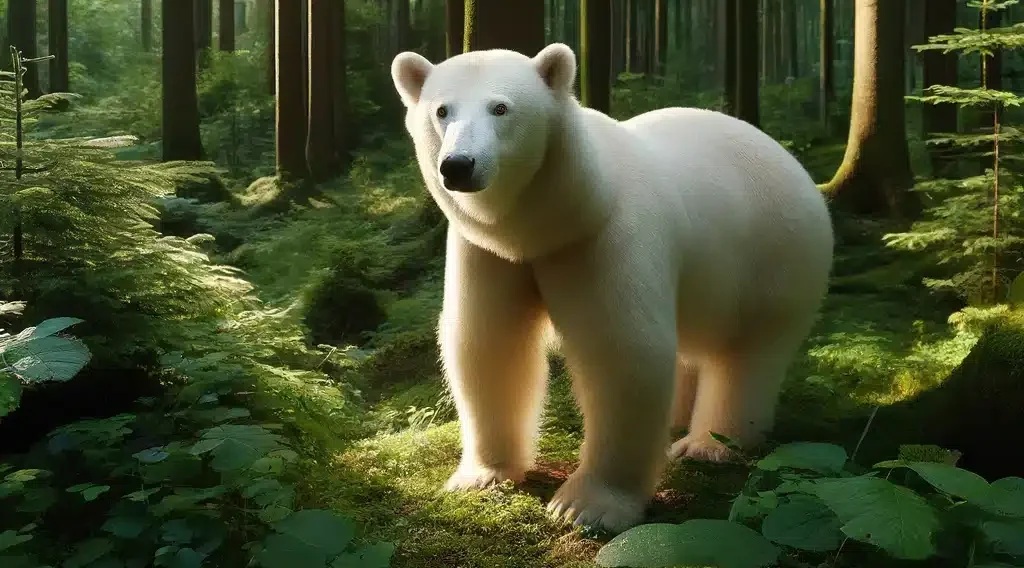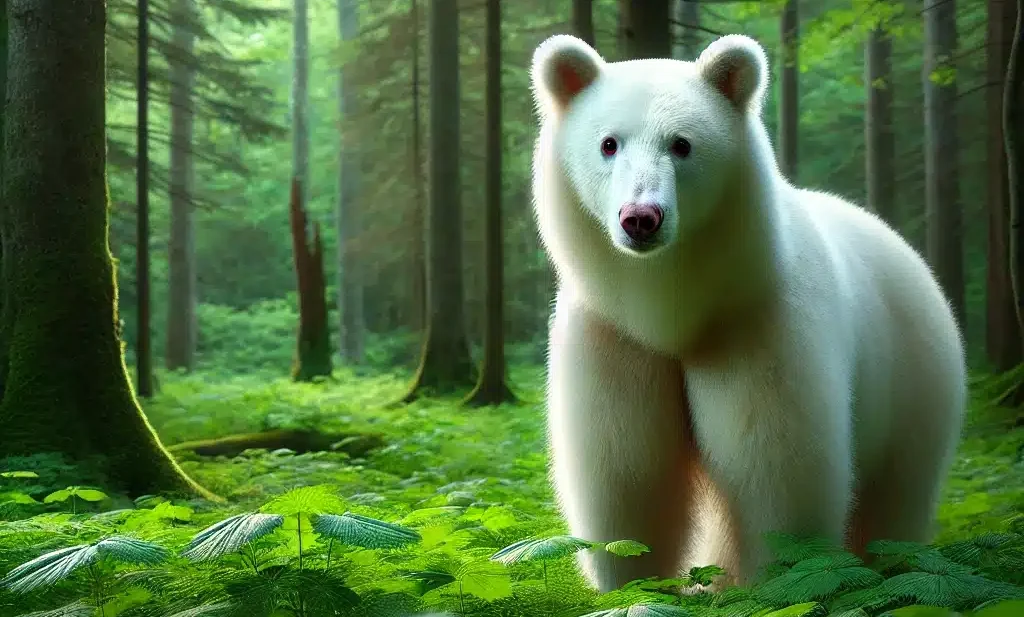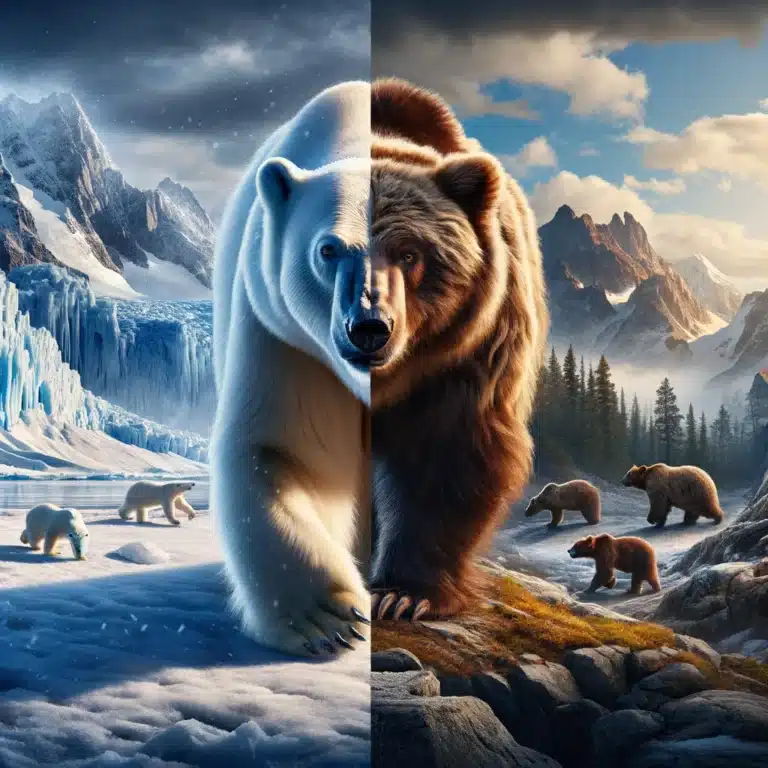Imagine a massive bear, its fur shimmering an ethereal white against the backdrop of a lush green forest. This isn’t a scene from a fantasy novel; it’s the awe-inspiring reality of the albino bear, a creature of myth and legend that comes to life.
In a fictional narrative, an albino brown bear named Joey has been mistakenly identified and relocated multiple times. Due to his unusual coloring, he is believed to be a polar bear.
This tale, labeled as the ‘unluckiest bear in the world,’ highlights the misunderstandings and sensationalism surrounding wildlife conservation.

Throughout history, albino animals have captivated our imaginations. Their lack of pigmentation creates a striking appearance, setting them apart from their brethren.
Among these rarities, the albino bear stands out as a symbol of untamed wilderness and breathtaking beauty. But beyond their captivating looks lies a fascinating story of genetics, adaptation, and the delicate balance of nature.
What is Albinism and How Does it Affect Bears?
Albinism is a genetic condition that affects the production of melanin, the pigment responsible for skin, hair, and eye color. In albino bears, a malfunction in melanin production results in a complete or partial absence of pigment, leading to their characteristic white or cream fur. This condition can manifest in two main forms:
Oculocutaneous Albinism (OCA) is the most common form affecting the skin and eyes. Albino bears with OCA have white fur, pink noses and paw pads, and light-colored eyes that may appear pinkish or reddish due to underlying blood vessels.
Ocular Albinism: This rarer form primarily affects the eyes, with fur pigmentation remaining relatively normal. Albino bears with ocular albinism may have brown or black fur but exhibit light-colored eyes with vision problems.
In contrast, black bear color phases refer to the various color variations in black bears, ranging from black and brown to cinnamon and even white. These color phases are influenced by genetics and environmental factors, with certain areas exhibiting a higher prevalence of lighter-colored bears to reduce heat stress and improve camouflage.
A Life of Challenges: The Struggles of Albino Bears

While their white fur might seem majestic, it presents a significant challenge for albino bears in the wild. Here’s why:
Camouflage Complications: A bear’s dark fur acts as natural camouflage, allowing them to blend into their surroundings while hunting prey or avoiding predators. Albino bears, lacking this camouflage, struggle to stalk prey effectively and become more vulnerable to attacks.
Vision Issues: Some albino bears, particularly those with Oculocutaneous Albinism, may have poorer eyesight due to reduced light sensitivity in their light-colored eyes. This can make it difficult for them to navigate their environment, hunt efficiently, and avoid potential dangers.
Social Exclusion: Within bear societies, fur color plays a role in communication and social interactions. Albino bears may face social exclusion from their groups due to their distinct appearance.
Animal welfare groups generally do not participate in the relocation of wildlife, particularly albino bears, across great distances or international borders due to limitations in management authority and funding.
Transporting animals, such as the albino bear mistakenly identified as a polar bear, would require significant resources and collaboration, which these organizations typically lack.
However, despite these challenges, albino bears exhibit remarkable resilience. They adapt their hunting strategies, rely more on their sense of smell and hearing, and sometimes even compensate for vision problems by hunting during lower light conditions like dusk or dawn.

Albino Grizzly Bear Mistaken for Polar Bear
In the wild, an albino grizzly bear is an extraordinarily rare sight, and its unusual appearance can often lead to confusion. These bears, lacking the typical brown fur and possessing striking white or pale fur, pink eyes, and noses, are sometimes mistaken for polar bears or other species by those unfamiliar with their unique condition.
For instance, an albino grizzly bear named Joey has been mistaken for a polar bear and airlifted to the Arctic several times due to his unique white appearance.
The rarity of albinism in grizzlies adds to the intrigue, making any sighting a significant event for wildlife enthusiasts and researchers. However, this distinctive trait also makes them more vulnerable in the wild, as they may struggle with camouflage and face additional environmental challenges.

Conclusion: Coexisting with the Albino Bear
The albino bear is a captivating reminder of nature’s wonders and the ecosystem’s delicate balance. Its rarity and challenges inspire awe, while its resilience teaches us about adaptation and survival. But our appreciation shouldn’t stop at admiration.
By committing to responsible observation and supporting conservation efforts, we can ensure the continued existence of these magnificent creatures. Let’s move beyond simply marveling at the “ghost of the forest” and take action to ensure their future remains as bright as their unique fur.
The next time you explore the wilderness, remember the albino bear—a symbol of nature’s beauty and vulnerability and a call to become a responsible steward of our wild spaces.
Albino Bear FAQs

Where can I see an albino bear?
Albino bears are rare, and sightings are uncommon. However, some regions with established bear populations, particularly black and grizzly bears, may have a higher chance of spotting an albino individual.
Is the albino grizzly bear mistaken for a polar bear very often?
No, albino grizzly bears are not often mistaken for polar bears. While both have light-colored fur, the two species have several distinguishing features. Polar bears have a more slender body shape, longer necks, and smaller, more rounded ears than grizzlies.




